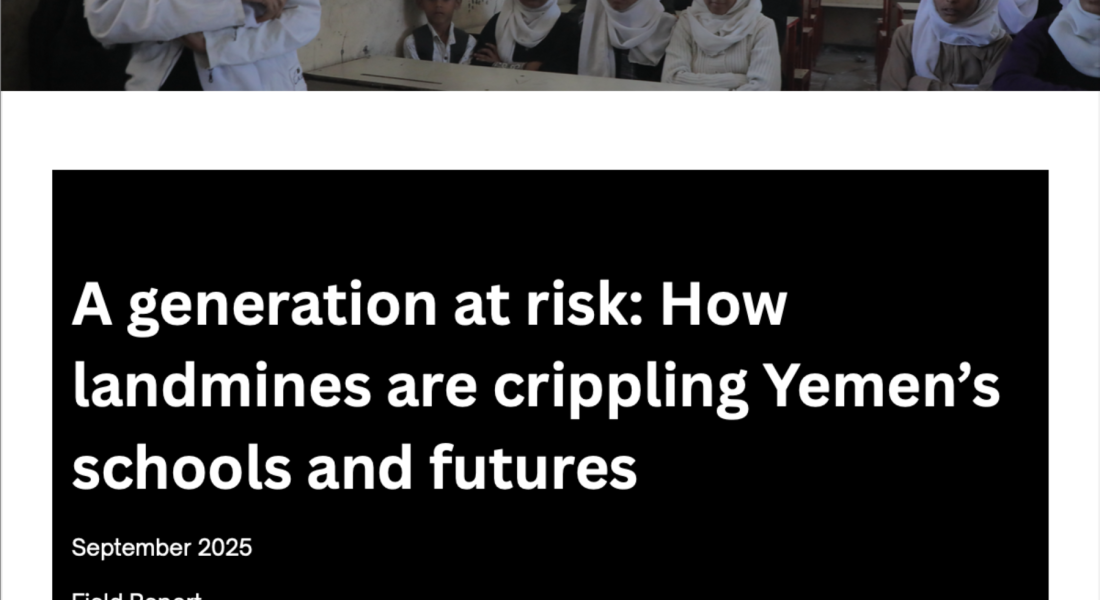On a September morning in Taiz, parents gather outside the gates of Ibrahim Aqeel School, scanning the dusty yard and ruins of the demolished classrooms for hidden explosives before daring to walk their children in. This grim ritual is part of daily life for thousands of Yemeni families who must choose between education and survival.
A new field report, A Generation at Risk, lays bare how landmines and improvised explosive devices (IEDs) are dismantling Yemen’s education system and condemning an entire generation to fear and lost opportunity. The findings, drawn from Project Masam’s operations across the country, reveal a pattern of deliberate attacks on schools and the children who depend on them.
Schools as targets
According to the report, Houthi forces have planted landmines and IEDs in and around at least 344 schools across six governorates – Taiz, Marib, Hudaydah, Shabwah, Hajjah and Al-Jawf. In the report, Project Masam claims this is no accident but a calculated strategy.
By seeding classrooms and schoolyards with explosives, the Houthis disrupt education, destabilise communities and spread fear, undermining government control and making it harder for families to return home.
“Every mine left in the ground is a lesson denied,” said Project Masam Managing Director Ousama Algosaibi. “By destroying classrooms and planting fear, they aim to keep communities uneducated and easier to control, using ignorance as a tool to entrench their ideology and weaken future resistance.”
The tactic is brutally effective: parents keep children home, teachers flee, and classrooms become no-go zones even after the fighting stops.
Children trapped in conflict
The human toll is staggering. More than 3.7 million children are already out of school. Between August 2023 and July 2024, 115 civilians were killed or injured by explosive remnants of war, 40 percent of them women and children.
Eight-year-old Hadi Abdo Fadel lost three fingers after picking up what he thought was a toy in his schoolyard – it was a landmine detonator. Thirteen-year-old Ilham Sahili lost both legs when the donkey she was riding stepped on a mine; her brother was killed in a separate blast. A double amputee, Ilham now struggles to get to school and fears the impact the explosion had could keep her away from school.
“I don’t want to become a victim of ignorance as well,” Ilham said. “Even if it is slow, I will keep trying until I succeed.”
A system on the brink
The war’s impact on education goes beyond shattered buildings. Teachers in Houthi-controlled areas have gone years without salaries, and in government-held districts wages hover around US$30 a month (far below basic living costs). Families who keep children at home to avoid mines face impossible choices: girls pushed into early marriage, boys into child labour or recruitment by armed groups.
Grade 8 students in Taiz now sit for exams on rooftops under the blazing sun because their classrooms were destroyed by explosions. In Hajjah, hundreds of children study in open air after their school was bombed. In many communities, the fear of hidden mines outweighs even the will to rebuild, as no one knows what lays below the rubble.
Clearing the way back to learning
Since 2018, Project Masam has removed over 515,000 explosive threats and cleared more than 70 million square metres of land.
In Taiz’s Dhubab area, Demining Teams 27 and 28 uncovered and neutralised more than 50 banned anti-personnel mines in and around Al-Omari School, where students once reported unexploded shells and a landmine detonation.
Elsewhere, demining teams like those led by Engineer Abdo Ibrahim painstakingly sift through rubble, finding devices buried beneath classroom floors and playgrounds.
“Clearing mines is more than removing explosives,” Algosaibi said. “It’s about giving children their right to learn in safety.”
The report urges sustained international support and better coordination between mine action and education funding—teacher stipends, classroom repairs, and transparent clearance data—to ensure that a safe road leads to a functioning school.
The stakes for Yemen’s future
Each school that reopens after clearance is a small victory. In Al-Dhaweha village, deminers secured Omar bin Abdulaziz School, allowing construction crews to add three new classrooms. “By the grace of God, the danger was removed and the area secured,” said construction supervisor Muhammad Sadiq Ali Saeed.
But countless others remain inaccessible. “Every child who cannot safely reach a classroom is a tragedy for that family, and a loss for Yemen’s future,” Algosaibi warned. “Every mine left in the ground is a lesson denied.”
The report warns that failing to act now will ripple far beyond education. An entire generation deprived of safe schooling risks becoming unemployable and unable to sustain livelihoods, participate in peacebuilding, or fight for their rights. Without urgent clearance and investment, Yemen could face a future with millions of young people shut out of the workforce and excluded from the very processes of recovery, development, and prosperity that the country so desperately needs.
Download the report here.

